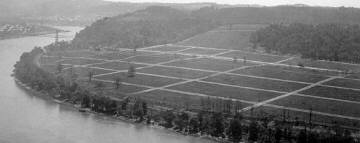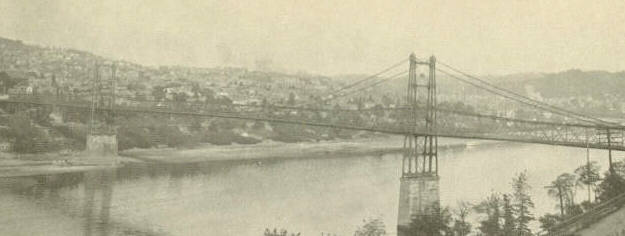 The West Virginia track held high promise for the potters -- it was one of the few large flat areas which could suit a giant factory system and a community of workers. It was on the river and it was in a state which had lower taxes than Ohio.
In October 1902 it was disclosed that the 428-acre site had been purchased for some $75,000 from Elijah Hill, who obtained it form the Llyod syndicate. The tract had been patted and laid out into streets and town lots, some being sold to East Liverpool people. The West Virginia track held high promise for the potters -- it was one of the few large flat areas which could suit a giant factory system and a community of workers. It was on the river and it was in a state which had lower taxes than Ohio.
In October 1902 it was disclosed that the 428-acre site had been purchased for some $75,000 from Elijah Hill, who obtained it form the Llyod syndicate. The tract had been patted and laid out into streets and town lots, some being sold to East Liverpool people.
The late James Newell, several years ago, stated that the Llyod syndicate failed to develop the planned steel mill at the site because of the financial insecurity of the early 1890's. Later a plant the syndicate controlled at Pittsburgh was purchased by the U.S. Steel Corp., he said.
Newell said he and the Hill brothers invested in the property, which was purchased later by the North American Manufacturing co. after he and the Hills had laid out the town site.
Plans called for the streetcar lines to be brought down from Chester, but streetcar interests blocked the move, according to Newell and some of the leading officials almost decided to give up the pottery site in favor of another at Alliance, where some land even had been optioned.
However, a stockholders' group obtained money to construct the bridge, and plans for the span were developed. Objections were raised by boat firms who claimed the navigation channel was endangered. But government authorities approved the bridge when these claims were shown to be unfounded.
Heading the North American Manufacturing syndicate was Louis Aaron of Pittsburgh, president of the Homer Laughlin China Co., and Joseph G. Lee, secretary and general manager of the Knowles, Taylor and Knowles Co. of East Liverpool and member of the Taylor, Lee & Smith Co. [1] of Chester.
The land included the 61-acre farm of William McDonald the 155-acre Wells farm, known as the Murry tract, the Moore tract of 129 acres, John Newell farm of 67 acres and the J. Bentley Newell tract of 16 acres.
Well in the planning stages were a bridge, some pottery construction and a street car line.
By the next month - November 1902 - the joint enterprise was unfolded. A charter was granted to the North American Manufacturing Co. with a capital stock of $1 million. Listed as incorporators were Louis Aaron, president of Laughlin, Charles Aaron, stockholder and connected with the decorating departments, and Marcus Aaron, large stockholder; W. E. Wells, general secretary and treasurer of the Laughlin firm, George W. Clark, second vice president of Laughlin and West Coast sales representative; W. M. Knowles, president of the Edwin M. Knowles China Co. of Chester; John Taylor, president of KT&K Co., and Lee.[2]
Preliminary surveys were launched in 1903 for the much needed bridge to provide a link with the town site then reached only by way of the ferryboat, "Ollie Neville."
Work on the $250,000 span began in 1904. It was constructed in 13 months, a shorter time than the Chester span, which was built in a year and five months.
First excavation for the approaches and abutments for the bridge was started June 2, 1904, and the first crossing was made July 4, 1905. A similar span at Steubenville [3] was started months before the Newell bridge but was opened only two days before.
 Cables on the Newell bridge were strung in the middle of winter, while cables on the other spans were strung in summer. E.K. Morse, noted area river engineer, was in charge of the work done by the Penn Bridge Co. of Beaver Falls, with the Ohio Steel Erecting Co. of Steubenville as subcontractors.
The bridge construction marked the start of a three-year period of intense building on the south bank of the Ohio River. Cables on the Newell bridge were strung in the middle of winter, while cables on the other spans were strung in summer. E.K. Morse, noted area river engineer, was in charge of the work done by the Penn Bridge Co. of Beaver Falls, with the Ohio Steel Erecting Co. of Steubenville as subcontractors.
The bridge construction marked the start of a three-year period of intense building on the south bank of the Ohio River.
Besides the work on the bridge, work was under way on Dam No. 8, part of a series of river dams designed to bring the river to a 9-foot depth for year round navigation, and construction of the new pottery and homes in Newell along with public utility projects such as roadways, water systems, and streetcar lines also made the former farm land a hub of activity.
Much of the rivet work on the suspension span, 1,592 feet long with a channel span of 750 feet, had been done by hand instead of with machines, because workmen contended the machines were not adapted to bridge work.
The bridge's original wooden flooring was replaced with new wood flooring in 1923 and some addition steel stringers added. In 1954, the wood floor was ripped up and a steel grill flooring was installed to maintain the span as a vital link between the town and its plants with other communities across the Ohio.
1 This pottery would eventually become the Taylor, Smith & Taylor Co. It closed in 1981.
2 Besides those already listed, an issue of Glass and Pottery World Vol XIII, No. 1, dated January 1905, also notes the following were part of the American Manufacturing Company; W.W. & H.N. Harker of the Harker Pottery Company, Aaron Cohen, F.D. Kitchell, R. B. Lawrence of the Newell Bridge Company, Attorney W. B. Hill, and the Rauh Brothers.
According to The Richard E. Rauh Papers at the Heinz History Center in Pittsburgh, the Rauh brothers were Enoch, Marcus, and Abraham. Enoch was a prominent businessman in Pittsburgh and was the senior member of Rauh Brothers & Company.
3 This would be the Market Street bridge. It underwent renovations in 2010-2011.
|